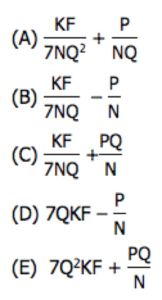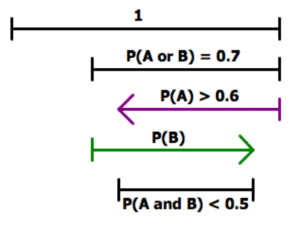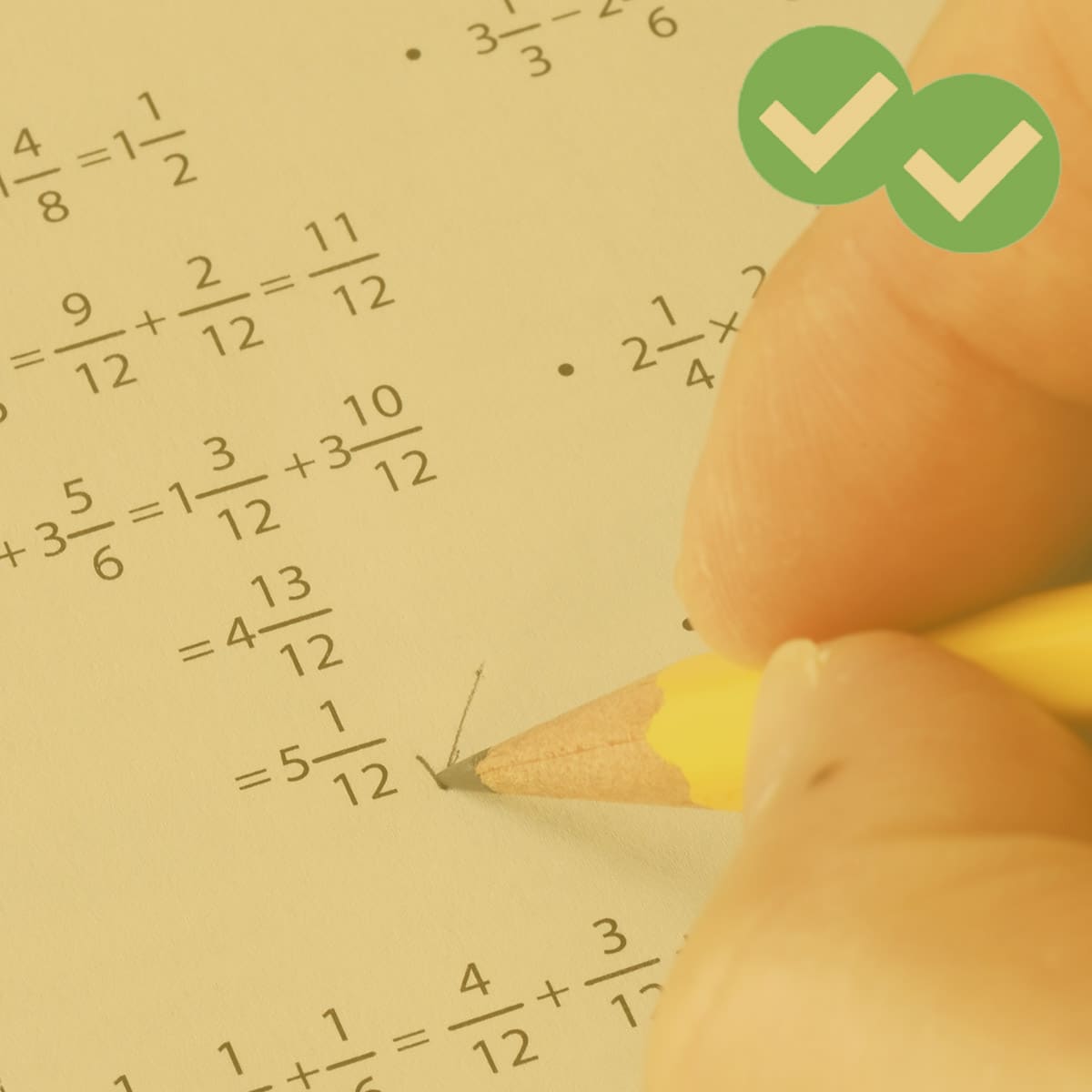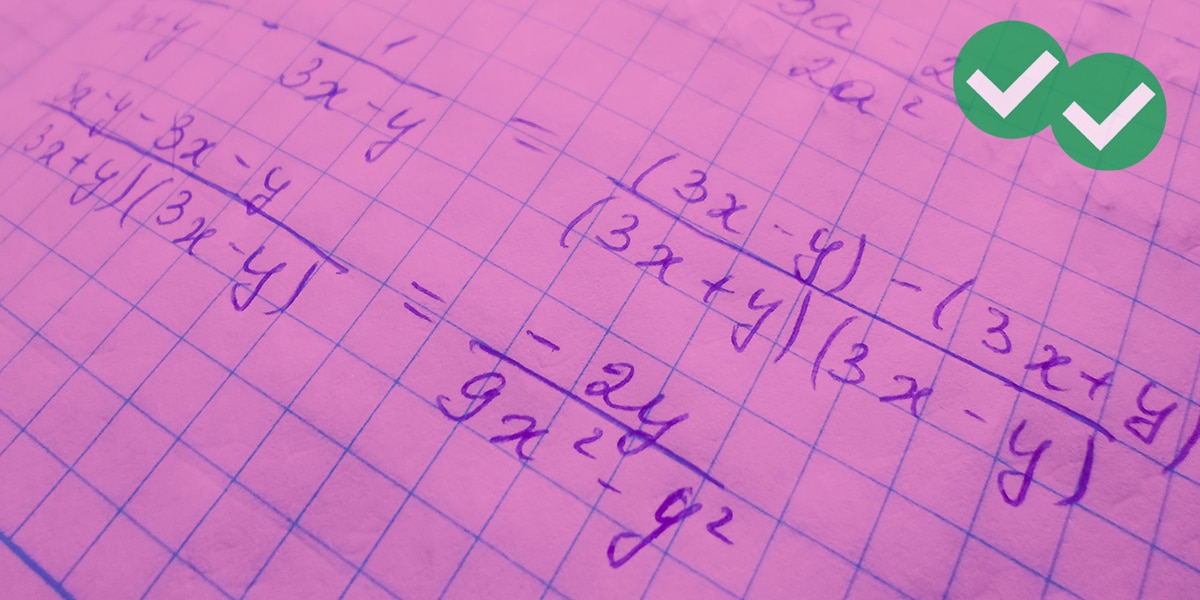Here are eight challenging GMAT Quantitative Reasoning (QR) questions, with explanations below. Working these questions will likely not be an easy feat; however, if you want to layer in an additional challenge, try to adhere to the ideal GMAT Quant section pace: That means completing each of the eight questions in about 2.15 minutes. Once you’ve mastered the approach to these difficult math questions, which might take a bit of time and effort, head over to our full GMAT practice test to really test your skills.
As always, remember there’s no calculator use permitted on the GMAT QR section.
Given the lack of access to a calculator, you’ll want to start practicing mental math tricks to help decrease the time it takes to work the steps of a problem. Before you attack the questions, check out this handy tip for dividing:
Ready, Set, Go!
GMAT Practice Question 1
Let abcd be a general four-digit number and all the digits are non-zero. How many four-digits numbers abcd exist such that the four digits are all distinct and such that a + b + c = d?
(A) 6
(B) 7
(C) 24
(D) 36
(E) 42
GMAT Practice Question 2
There are 500 cars on a sales lot, all of which have either two doors or four doors. There are 165 two-door cars on the lot. There are 120 four-door cars that have a back-up camera. Eighteen percent of all the cars with back-up cameras have standard transmission. If 40% of all the cars with both back-up cameras and standard transmission are two-door cars, how many four-door cars have both back-up cameras and standard transmission?
(A) 18
(B) 27
(C) 36
(D) 45
(E) 54
GMAT Practice Question 3
At Mnemosyne Middle School, there are 700 students: all the students are boys or girls in the 4th or 5th grade. There are 320 students in the 4th grade, and there are 210 girls in the 5th grade. Fifty percent of the 5th graders and 40% of the 4th graders take Mandarin Chinese. Ninety 5th grade boys do not take Mandarin Chinese. The number of 4th grade girls taking Mandarin Chinese is less than half of the number of 5th grade girls taking Mandarin Chinese. Which of the following could be the number of 4th grade boys in Mandarin Chinese?
(A) 10
(B) 40
(C) 70
(D) 100
(E) 130
GMAT Practice Question 4
Suppose a “Secret Pair” number is a four-digit number in which two adjacent digits are equal and the other two digits are not equal to either one of that pair or each other. For example, 2209 and 1600 are “Secret Pair” numbers, but 1333 or 2552 are not. How many “Secret Pair” numbers are there?
(A) 720
(B) 1440
(C) 1800
(D) 1944
(E) 2160
GMAT Practice Question 5
In the coordinate plane, line L passes above the points (50, 70) and (100, 89) but below the point (80, 84). Which of the following could be the slope of line L?
(A) 0
(B) 1/2
(C) 1/4
(D) 2/5
(E) 6/7
GMAT Practice Question 6
At the beginning of the year, an item had a price of A. At the end of January, the price was increased by 60%. At the end of February, the new price was decreased by 60%. At the end of March, the new price was increased by 60%. At the end of April, the new price was decreased by 60%. On May 1st, the final price was approximately what percent of A?
(A) 41%
(B) 64%
(C) 100%
(D) 136%
(E) 159%
GMAT Practice Question 7
Suppose that, at current exchange rates, $1 (US) is equivalent to Q euros, and 1 euro is equivalent to 7Q Chinese Yuan. Suppose that K kilograms of Chinese steel, worth F Chinese Yuan per kilogram, sold to a German company that paid in euros, can be fashioned into N metal frames for chairs. These then are sold to an American company, where plastic seats & backs will be affixed to these frames. If the German company made a total net profit of P euros on this entire transaction, how much did the US company pay in dollars for each frame?

GMAT Practice Question 8
On any given day, the probability that Bob will have breakfast is more than 0.6. The probability that Bob will have breakfast and will have a sandwich for lunch is less than 0.5. The probability that Bob will have breakfast or will have a sandwich for lunch equals 0.7. Let P = the probability that, on any given day, Bob will have a sandwich for lunch. If all the statements are true, what possible range can be established for P?
(A) 0 < P < 0.6
(B) 0 ≤ P < 0.6
(C) 0 ≤ P ≤ 0.6
(D) 0 < P < 0.7
(E) 0 ≤ P < 0.7
Practice Problem Explanations
Explanation 1
Answer = (E)
We need sets of three distinct integers {a, b, c} that have a sum of one-digit number d. There are seven possibilities:
- a) {1, 2, 3}, sum = 6
- b) {1, 2, 4}, sum = 7
- c) {1, 2, 5}, sum = 8
- d) {1, 3, 4}, sum = 8
- e) {1, 2, 6}, sum = 9
- f) {1, 3, 5}, sum = 9
- g) {2, 3, 4}, sum = 9
For each set, the sum-digit has to be in the one’s place, but the other three digits can be permutated in 3! = 6 ways in the other three digits. Thus, for each item on that list, there are six different possible four-digit numbers. The total number of possible four-digit numbers would be 7*6 = 42.
Explanation 2
Answer = (B)
Total number of cars = 500
2D cars total = 165, so
4D cars total = 335
120 4D cars have BUC
“Eighteen percent of all the cars with back-up cameras have standard transmission.”
18% = 18/100 = 9/50
This means that the number of cars with BUC must be a multiple of 50.
How many 2D cars can we add to 120 4D cars to get a multiple of 50? We could add 30, or 80, or 130, but after that, we would run out of 2D cars. These leaves three possibilities for the total number with BUC:
If a total of 150 have BUC, then 18% or 27 of them also have ST.
If a total of 200 have BUC, then 18% or 36 of them also have ST.
If a total of 250 have BUC, then 18% or 45 of them also have ST.
Then we are told: “40% of all the cars with both back-up cameras and standard transmission are two-door car.”
40% = 40/100 = 2/5
This means that number of cars with both back-up cameras and standard transmission must be divisible by 5. Of the three possibilities we have, only the third words.
Total cars with BUC cams = 250 (120 with 4D and 130 with 2D)
18% or 45 of these also have ST.
40% of that is 18, the number of 2D cars with both BUC and ST.
Thus, the number of 4D cars with both BUC and ST would be
45 – 18 = 27
Explanation 3
Answer = (D)
700 student total
4G = total number of fourth graders
5G = total number of fifth graders
We are told 4G = 320, so 5G = 700 – 320 = 380
5GM, 5GF = fifth grade boys and girls, respectively
We are told 5GF = 210, so 5GM = 380 – 210 = 170
4GC, 5GC = total number of 4th or 5th graders, respectively taking Chinese
We are told
5GC = 0.5(5G) = 0.5(380) = 190
4GC = 0.4(4G) = 0.4(320) = 128
4GFM, 4GMC, 5GFC, 5GMC = 4th/5th grade boys & girls taking Chinese
We are told that, of the 170 fifth grade boys, 90 do not take Chinese, so 170 = 90 = 80 do. Thus 5GMC = 80.
5GMC + 5GFC = 5GC
80 + 5GFC = 190
5GFC = 110
We are told:
4GFM < (0.5)(5GFC)
4GFM < (0.5)(100)
4GFM < 55
Thus, 4GFM could be as low as zero or as high as 54.
4GMC = 4GC – 4GFM
If 4GFM = 0, then 4GMC = 128 – 0 = 128
If 4GFM = 54, then 4GMC = 128 – 54 = 74
Thus, fourth grade boys taking Mandarin Chinese could take on any value N, such that 74 ≤ N ≤ 128. Of the answer choices listed, the only one that works is 100.
Explanation 4
Answer = (D)
There are three cases: AABC, ABBC, and ABCC.
In case I, AABC, there are nine choices for A (because A can’t be zero), then 9 for B, then 8 for C. 9*9*8 = 81*8 = 648.
In case II, ABBC, there are 9 choices for A, 9 for B, and 8 for C. Again, 648.
In case III, ABCC, there are 9 choices for A, 9 for B, and 8 for C. Again, 648.
48*3 = (50 – 2)*3 = 150 – 6 = 144
3*648 = 3(600 + 48) = 1800 + 144 = 1948
Explanation 5
Answer = (D)
One point is (50, 70) and one is (100, 89): the line has to pass above both of those. Well, round the second up to (100, 90)—if the line goes above (100, 90), then it definitely goes about (100, 89)!
What is the slope from (50, 70) to (100, 90)? Well, the rise is 90 – 70 = 20, and the run is 100 – 50 = 50, so the slope is rise/run = 20/50 = 2/5. A line with a slope of 2/5 could pass just above these points.
Now, what about the third point? For the sake of argument, let’s say that the line has a slope of 2/5 and goes through the point (50, 71), so it will pass above both of the first two points. Now, move over 5, up 2: it would go through (55, 73), then (60, 75), then (65, 77), then (70, 79), then (75, 81), then (80, 83). This means it would pass under the third point, (80, 84). A slope of 2/5 works for all three points.
We don’t have to do all the calculations, but none of the other slope values works.
Explanation 6
Answer = (A)
The trap answer is 100%: a percent increase and percent decrease by the same percent do not cancel out.
Let’s say that the A = $100 at the beginning of the year.
End of January, 60% increase. New price = $160
End of February, 60% decrease: that’s a decrease of 60% of $160, so that only 40% of $160 is left.
10% of $160 = $16
40% of $160 = 4(16) = $64
That’s the price at the end of February.
End of March, a 60% increase: that’s a increase of 60% of $64.
10% of $64 = $6.40
60% of $64 = 6(6 + .40) = 36 + 2.4 = $38.40
Add that to the starting amount, $64:
New price = $64 + $38.40 = $102.40
End of April, 60% decrease: that’s a decrease of 60% of $102.40, so that only 40% of $102.40 is left.
At this point, we are going to approximate a bit. Approximate $102.40 as $100, so 40% of that would be $40. The final price will be slightly more than $40.
Well, what is slightly more than $40, as a percent of the beginning of the year price of $100? That would be slightly more than 40%.
Explanation 7
Answer = (A)
The K kilograms, worth F Chinese Yuan per kilogram, are worth a total of KF Chinese Yuan. The German company must pay this amount.
Since 1 euro = (7Q) Chinese Yuan, then (1/(7Q)) euro = 1 Chinese Yuan, and (KF/7Q) euros = KF Chinese Yuan. That’s the amount that the Germans pay to the Chinese.
![]()
That is the German company’s outlay, in euros. Now, they make N metal chairs, and sell them, making a gross profit of P euros.

That must be the total revenue of the German company, in euros. This comes from the sale to the American company. Since $1 = Q euros, $(1/Q) = 1 euro, so we change that entire revenue expression to euros to dollars, we divide all terms by Q.

That must be the total dollar amount that leaves the American company and goes to the German company. This comes from the sale of N metal frames for chairs, so each one must have been 1/N of that amount.
![]()
Explanation 8
Answer = (B)
Let A = Bob eats breakfast, and B = Bob has a sandwich for lunch. The problem tells us that:
P(A) > 0.6
P(A and B) < 0.5
P(A or B) = 0.7
First, let’s establish the minimum value. If Bob never has a sandwich for lunch, P(B) = 0, then it could be that P(A and B) = 0, which is less than 0.5, and it could be that P(A) = 0.7, which is more than 0.6, so that P(A or B) = 0.7. All the requirements can be satisfied if P(B) = 0, so it’s possible to equal that minimum value.
Now, the maximum value. Since P(A or B) = 0.7, both P(A) and P(B) must be contained in this region. See the conceptual diagram.

The top line, 1, is the entire probability space. The second line, P(A or B) = 0.7, fixes the boundaries for A and B. P(A) is the purple arrow, extending from the right. P(B) is the green arrow extending from the left. The bottom line, P(A and B) < 0.5, is the constraint on their possible overlap.
Let’s say that P(A) is just slightly more than 0.6. That means the region outside of P(A), but inside of P(A or B) is slightly less than 1. That’s the part of P(B) that doesn’t overlap with P(A). Then, the overlap has to be less than 0.5. If we add something less than 1 to something less than 5, we get something less than 6. P(B) can’t equal 0.6, but it can any value arbitrarily close to 0.6.
Thus, 0 ≤ P(B) < 0.6.
Summary
Alright, you’ve made it through these eight challenging questions, and you’ve given yourself time to absorb the strategies and techniques provided in the explanations. Well done, you! Now, if you are hankering for more GMAT math practice, check out this GMAT Diagnostic Quiz. Or, if you desire the full GMAT experience, check out our GMAT practice test.
Happy Studying!





